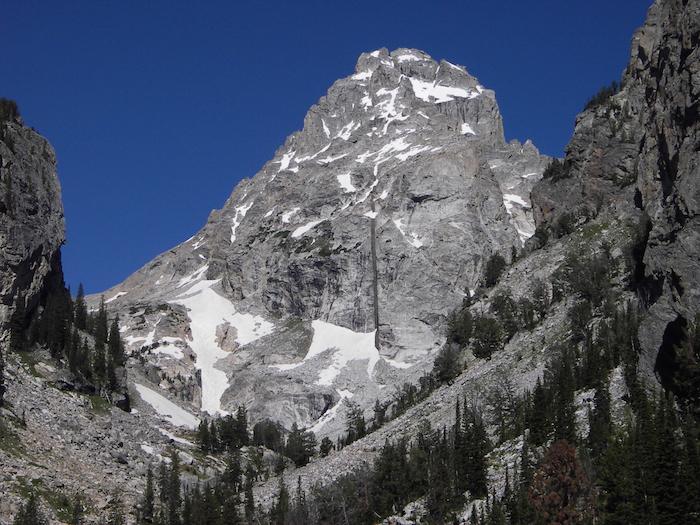
Two brothers needed to be air-lifted off Middle Teton at Grand Teton National Park after becoming overcome by fatigue/NPS file photo
Two brothers who found themselves at their physical limits in Grand Teton National Park received a helicopter shuttle off Middle Teton rather than push their luck in finding a safe way down.
Climbing rangers used the "short-haul" technique, in which the brothers separately were placed in evacuation harnesses that were then attached to a 100-200-foot rope dangling from the bay of a helicopter and air-lifted down to Lupine Meadows.
The rescue began Tuesday when Nick Christu, 64, and his brother Eric Christu, 57, from Palm Beach, Florida, decided they were unable to continue their climb after getting off route while attempting to ascend the ‘Dike Route’ on the Middle Teton. The two told rangers they had nearly 40 years of climbing experience in the Tetons, but Tuesday's climb turned out to be too demanding, as this park release illustrates:
Unable to locate the top of the Dike Pinnacle, a prominent feature of the route, the Christu brothers began down climbing and rappelling towards the South Fork of Garnet Canyon. Due to their uncertainty about the terrain they encountered, combined with their state of exhaustion, the Christus called park rangers at mid-afternoon to request a rescue from their predicament.
Upon receiving the first call for help at approximately 3:45 p.m., rangers made several attempts via cell phone to direct the Christu brothers into easier terrain so they could continue their descent. Those efforts failed due to the climbers’ level of fatigue and their inability to keep moving. Continued requests by the climbers for a rescue, combined with concern regarding their mental and physical state, prompted park rangers to determine that the best option for the Christu brothers’ safety would be to short-haul the pair off the mountain. A Teton Interagency contract helicopter was summoned, and the ship arrived at the Jenny Lake Rescue Cache at 5 p.m. One ranger was inserted via short-haul to prepare the climbers for an aerial rescue by placing them in an evacuation harness. The climbers were then flown in separate trips and delivered to the rescue cache at Lupine Meadows. The rescue mission concluded at 7:40 p.m.
Park officials note that while many climbers consider the Dike Route—rated 5.5 – 5.6 on the Yosemite Decimal System—to be an easy route, "those attempting this option should note that it includes almost 3,000 vertical feet of climbing through complex terrain. Parties descending the route from points other than the summit of the Middle Teton (elevation 12,804 feet) must be prepared for attentive route finding through loose rock that is much more challenging and complicated than the standard descent route via the Southwest Couloir."
While the helicopter time required for this rescue probably cost about $500, park officials will tap the National Park Service's search-and-rescue account to cover that rather than bill the brothers. Rescues of injured or fatigued backcountry travelers aren't typically billed, said Grand Teton spokeswoman Jackie Skaggs.
Grand Teton rangers want to underscore the point that calling for a rescue is a serious request, with the outcome never guaranteed. It is important for climbers and backcountry travelers to recognize the risk they are creating to others when requesting a rescue.



Comments
Hope these climbers make a generous donation to the National Park Service
A generous donation? How about $500. That was the cost. As a matter of fact the NPS budgets these costs. And the NPS will tell you that SAR is a miniscule fraction of the NPS budget. I'm just glad that the NPS gave an accurate dollar figure for the rescue instead of the inflated numbers they use here in the smokies every time some stupid dayhiker goes up to the Leconte Concession and becomes "fatigued".